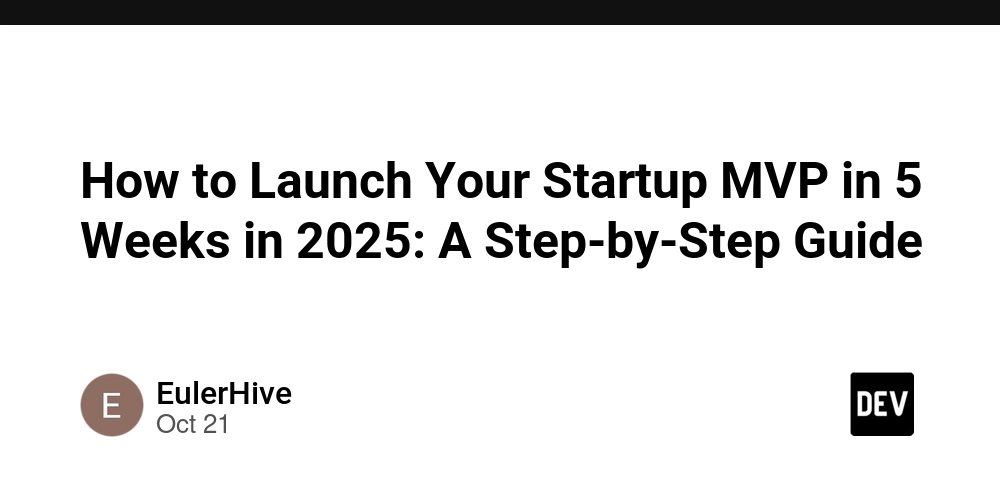When I started building my own startup, I had one goal — to turn ideas into something real fast enough to test if people even cared. That’s the truth most founders learn the hard way: it’s not about building a perfect product, it’s about learning fast and adapting even faster.
In 2025, speed is everything. The tools are smarter, AI is everywhere, and customers expect products to work right out of the gate. But despite all that, the fundamentals haven’t changed — execution, clarity, and discipline still win. Here’s what I’ve learned while building and launching MVPs (Minimum Viable Products) for startups and for my own company, EulerHive.
Week 1: Define the Core Problem, Ruthlessly
Most startup ideas fail not because they’re bad, but because they solve the wrong problem. When I began, I used to brainstorm features first — dashboards, automation, integrations. It felt productive, but it was a trap.
The real work is narrowing the problem down to a single, painful point. If your target user says, “I’d pay to fix this,” you’re on the right path. Forget 10 features; focus on one problem worth solving deeply.
Write it down in one sentence. That’s your north star for the next five weeks.
Week 2: Design the Experience, Not Just the Interface
In my early MVPs, I used to obsess over UI polish — gradients, typography, pixel perfection. Then I realized, users don’t care how pretty something is if it doesn’t work or make sense.
Instead, think in user stories. “As a small business owner, I want to track leads easily.” That’s the level of clarity that helps you design an experience, not just screens.
Tools like Figma or Framer let you move quickly. Build wireframes, test them with real users (even if that’s just a handful of friends), and take notes on where they hesitate or get confused. Those pauses are gold — that’s where the product needs refinement.
Week 3: Build Fast, Break Comfortably
Your MVP isn’t your final product. It’s an experiment. Use frameworks that get you results quickly — Next.js, Django, Node, whatever fits your stack. Don’t over-engineer. Use existing APIs and third-party tools. Automate only when it hurts.
One thing that saved me early on: focusing on outcomes, not output. If you can validate an idea with 500 lines of code instead of 5,000, do that. The goal isn’t to show off technical skill — it’s to learn if your solution matters.
Week 4: Test in the Wild, Not in Your Head
This is where many founders hesitate — they’re afraid of feedback. I get it; launching something raw feels like standing on stage in pajamas. But nothing accelerates learning faster than putting it in front of real users.
Get 10 people to try your MVP. Watch them use it. Don’t explain it to them. If they don’t understand it, your product needs to speak louder. Ask them one simple question: “Would you use this again?” Their hesitation tells you everything.
Be open to brutal feedback. It’s not rejection; it’s redirection.
Week 5: Polish, Present, and Prepare to Pivot
Now that you have data, tighten up your onboarding, fix the obvious bugs, and polish just enough to make it credible. Prepare a short story around your product — what problem it solves, why now, and what’s next.
Remember, an MVP’s goal is not perfection but proof — proof that your idea has legs. Once that’s clear, you can raise funds, grow your user base, and scale responsibly.
My Personal Notes for Founders
Don’t overthink your tech stack. Overthinking delays progress.
Don’t chase trends. Solve problems that make real people’s lives easier.
Don’t wait for “ready.” Ready is an illusion. Start small, launch fast, and learn constantly.
Do build relationships early. Feedback, mentors, and community save time.
Do keep your burn rate low. Freedom comes from frugality in the early stage.
Final Thoughts
When I built my first MVP, I had no roadmap — just curiosity, caffeine, and conviction. I made mistakes, launched half-broken prototypes, and rebuilt them from scratch. But each one taught me something priceless: execution beats ideas every time.
If you’re planning to launch your startup in 2025, you don’t need millions or a big team. You need clarity, focus, and the willingness to learn in public.
At EulerHive, this is what we do every day — helping startups go from idea to MVP in weeks, not months. Whether it’s design, development, or strategy, we’ve walked this path and built systems to help others move faster, smarter, and stronger.
If you’re ready to bring your idea to life, I’d love to collaborate. Learn more about how we can help at EulerHive.com or connect with me personally on LinkedIn: linkedin.com/in/harshilsuthar. Because in the end, ideas only matter when they’re built.



